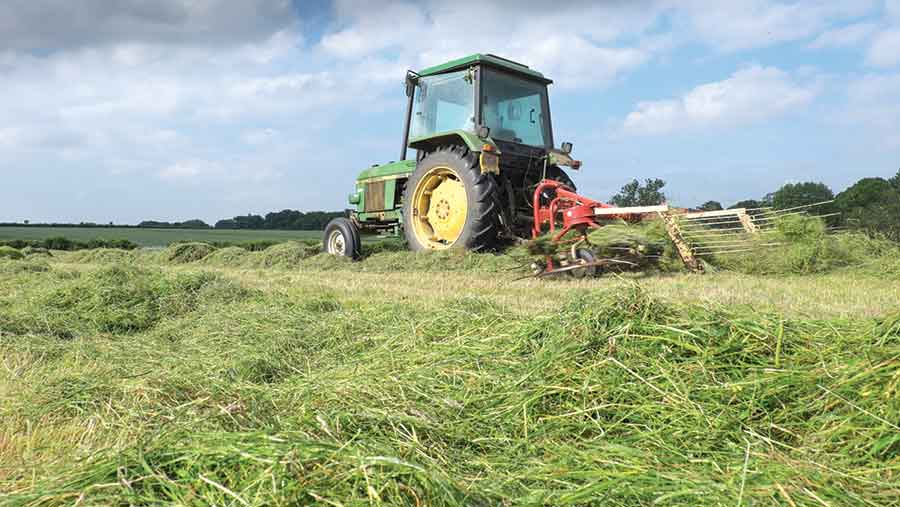How to maximise sugar content in grass silage
Improving the sugar or water soluble carbohydrate (WSC) content of UK grass silages is very important, as it is the first available energy source to the rumen bacteria.
Maximising the sugar content of grass silages will improve microbial protein synthesis in the rumen, therefore increasing the efficiency of meat and milk production.
Understanding the variables affecting sugar content is a key starting point that will help inform better silage-making decisions.
See also: 5-step guide to reducing silage losses

There are a number of conflicting factors that affect the residual content of sugar in silage.
Varieties of grass: Different varieties, otherwise known as cultivars, will vary in their sugar content as the season progresses. The time of day also affects the sugar content in the grass as indicated, so cutting time is important.

Mowing: Once grass is mown, sugar will disappear as a result of both plant respiration, because it’s still living, and the growth of undesirable aerobic micro-organisms.
Wilting: Grass is wilted to increase the sugar content relative to the dry matter through the evaporation of water. However, sugar content also reduces during wilting in relation to DM (see fig 1 “Wilting duration and the effects on WSC”).

Ensiling: If the DM of grass is low at ensiling more sugar is needed for fermentation, because acid in the liquid phase controls the fermentation.
Therefore the lower the DM the more water and the more acid needed for fermentation.
This acid is produced from sugar therefore lowering sugar content. Fig 2 (above) shows the results of over 300 UK farm silages analysed in 2015 through a commercial laboratory and indicates that as the DM increases so does the concentration of sugar in the silage.
So how can sugars be maintained at a maximum level?
Silage should be wilted as rapidly as possible to obtain the target of 30% DM in the shortest possible time.
In practice this means cutting the grass when it’s dry, spreading it immediately with a mower conditioner in as wide a swath as possible, preferably to cover the entire area it was cut from, thus improving the surface area for water evaporation.
Ideally cut at 2pm and pick up that evening, as this will give the best possible sugar content.
However, cutting in the morning and picking up the same day is likely to give you a higher sugar content in your silage than cutting in the afternoon and picking up the following day, due to the higher potential sugar losses by the longer wilting time.
Additives can also make a big difference to the sugar content in your silage.
A good homofermentative inoculant, one that just produces lactic acid from the most abundant grass sugars, will increase the sugar remaining in your silage at feed-out – providing the silage clamp is well managed and there is minimal aerobic spoilage at feed-out. It works by improving the silage fermentation.
Therefore less sugar is required to acidify the silage. However, non-lactic acid bacterial inoculants, and heterofermentative inoculants that produce a mixture of lactic and acetic acids, will reduce the sugar content in silages at feed-out, as their fermentation processes are less efficient acidifiers.

For example, fig 3 shows grass was ensiled at four different DM contents. At each DM grass was ensiled with one of three treatments, either a Lactobacillus plantarum (Homofermentative) inoculant, no additive or a mixture of L.plantarum and L buchneri (heterofermentative).
Results show that as the DM increases so does the sugar content with both the homofermentative inoculant and the untreated, whereas the mixed inoculant has a much less efficient fermentation and uses all the sugar during ensilage.

Chemical additives can also increase the sugar content as can be seen in fig 4 (grass ensiled at 20% DM).
The chemical additive in this study contained a mixture of benzoate, sorbate and nitrite salts designed to inhibit the growth of undesirable microbes in the silo, while enabling the natural lactic acid bacterial population present on the plant to grow.
At this low 20% DM there was a significant improvement in sugar content compared with the other two treatments.

The method of ensiling can also have an effect on the concentration of sugar in the silage. Bales with a more restricted fermentation generally contain more sugar than clamp silage and bales produced by a baler – where all the knives are chopping – at ensiling will have a higher sugar content than those bales produced without chopping (see fig 5 and 6).

